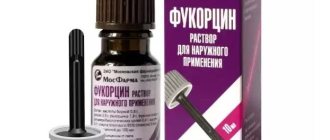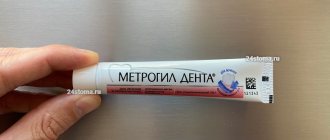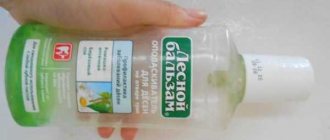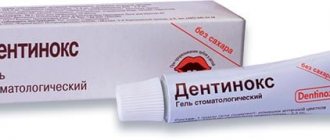Ointment "Vinilin": description, composition
The drug "Vinilin" is often called Shostakovsky's balm. Available in the form of an ointment. The main component is polyvinyl butyl ether (synonym: polyvinox). Physically it is a thick solution with a specific aroma. Available in bottles of 50 or 100 g.
The product has an antibacterial effect, inhibits inflammatory processes, stimulates tissue restoration and wound healing, and gives an enveloping effect.
Dehydrates bacterial cells, destroys their proteins, which leads to the death of pathogenic microorganisms. As a result, the affected cells in the body are restored faster due to the appearance of connective tissue.
Store Shostakovsky balm in normal room conditions, in the absence of sunlight. Should be kept away from children. The shelf life is 5 years from the date of production - after this time the medicine cannot be used.
How to treat ulcerative stomatitis?
Effective treatment of Vincent's ulcerative stomatitis should be comprehensive:
- Anesthesia – performed to relieve acute pain. Experts recommend applying compresses with pain-relieving solutions.
- Removing rashes. This should only be done by a doctor. First, compresses with a softening composition are applied to the ulcers, after which the crusts are gradually cleared from the surface of the mucosa, treating with hydrogen peroxide, potassium permanganate, chlorhexidine, etc.
- General treatment. It involves taking antihistamines that relieve general tissue irritation and the inflammatory process. For severe manifestations and complex symptoms, antibiotic therapy is prescribed. It is also recommended to take a course of vitamin therapy.
- Sanitation of the oral cavity. Effective treatment of caries, removal of pathological teeth. For wound healing, treatment with keratoplasty preparations, gels and ointments is recommended.
Indications, contraindications and side effects
The ointment is used externally as a primary or additional remedy for the treatment of the following skin diseases:
- burns;
- mastitis;
- boils;
- ulcers of trophic origin;
- frostbite;
- inflammation, including with ulcers;
- carbuncles.
In some cases, a thick solution is taken orally to treat ulcerative lesions of the DCT organs and gastritis, as well as for colitis. The use of the product must be agreed with a doctor.
The product has almost no contraindications - the ointment can be used by all patients, including children, with the exception of infants. It is also prohibited to take during pregnancy (any period) and breastfeeding. External use is allowed, but only in consultation with a doctor, when the expected benefits clearly outweigh the possible risks.
Use should be avoided in the presence of chronic renal and liver dysfunction. However, cases of overdose have not been registered: if you follow the instructions, the ointment is safe for health.
In the presence of individual intolerance, allergic reactions may occur. In this case, you should stop taking it immediately and consult your doctor about a possible replacement of the drug.
Contraindications for the drug Vinilin
- Children's age up to 14 years.
- Kidney and liver diseases.
- Individual intolerance to some components of the drug.
But very often dentists prescribe a balm for stomatitis for children who have not yet turned 14 years old. It is important that the child is not able to swallow the medicine. In addition, you need to carefully monitor the baby's condition: if you see the slightest rash, stop using the drug and show the child to the doctor.
Keep in mind that Vinilin can only eliminate the unpleasant manifestations of stomatitis; the causes of the development of the disease are hidden deeper. It is for this reason that you cannot treat with balm yourself. It is better to seek help from a dentist and pediatrician.
Features of use
Despite contraindications for the use of ointment before the age of 14, dentists often prescribe it for the treatment of stomatitis in children. You just need to follow the dosage and all the doctor’s recommendations.
The ointment should be used with extreme caution in children who are prone to allergies. In case of the slightest manifestation of an allergic reaction, you must stop using the drug, even if it copes well with the symptoms of the disease.
Often ointment is prescribed for the treatment of candidal stomatitis in infants. In this case, it is imperative to monitor the condition of the baby and follow the dosage.
"Vinilin": instructions for use
Vinilin ointment is used externally, applied to napkins, and then to the affected area (if necessary, it is first washed and wiped dry). Tablets are taken 1 pc. Once a day at night - preferably 5 hours after the last meal.
Instructions for using the solution internally are as follows:
- peptic ulcer – a teaspoon a day, then 1.5 times less, also once a day for 17-20 days;
- gastritis with high acidity, heartburn - one teaspoon on the first day, then 1.5 times less, also once a day for 9-11 days.
Shostakovsky's balm is used to treat stomatitis and treat ulcers. In this case, it is applied to a clean cotton stick and soaked into the affected area 2-3 times a day. After the procedure, you should not eat or drink for half an hour. To treat a sore throat, wipe the throat with a clean napkin, which is pre-moistened in Vinyl.
The main symptoms of Vincent's stomatitis
The most common symptom is the presence of numerous ulcerations in the oral cavity: on the inside of the cheeks, lips, palate and other areas. Other manifestations may vary, depending on the degree of the disease.
Symptoms of mild ulcerative stomatitis:
- increased salivation;
- pain in the mouth, especially when palpating soft tissues;
- bleeding gums, especially when eating and brushing teeth;
- swelling of the gums.
Manifestations of ulcerative necrotic stomatitis of the middle stage.
- wounds with necrotic crusts;
- bleeding gums;
- unpleasant odor;
- pus secreted from periodontal pockets;
- enlarged and painful lymph nodes;
- muscle weakness and loss of strength;
- temperature increase;
- loss of appetite.
Symptoms of ulcerative stomatitis of complex stage.
- severe weakness;
- stomach ache;
- nausea;
- vomit;
- increased body temperature;
- deep ulcers that can reach the bone tissue.
If these symptoms appear, you must immediately consult a dentist! The disease is treated exclusively under the supervision of an experienced doctor - treatment at home can significantly aggravate the situation.
Where to buy Vinilin: price, analogues, reviews
The product can be bought at a pharmacy without a prescription at an affordable price of 80 rubles for a 50 g pack or 130-150 rubles for a 100 g pack. Reviews about this ointment are extremely positive - almost 100% of buyers recommend it.
Among the positive aspects, they note the real effect, safety, almost complete absence of contraindications and side effects. Wounds and ulcers heal very quickly, while the skin is restored and looks attractive. Some patients successfully use the ointment to treat stomatitis in children. However, in such cases it is better not to risk it and consult a doctor.
One of the disadvantages is sometimes the sticky consistency associated with the fat base. The ointment may leave marks on clothing. Therefore, it is better to use it at home. Or make compresses with plastic bags to protect clothes.
How to treat ulcerative stomatitis with diet?
Diet alone will not be enough to completely cure the disease, but it is mandatory to speed up the recovery process. With such a diagnosis, it is very important to devote time to proper nutrition.
For stomatitis, the following products are recommended: vegetables, fruits, viscous porridges, greens, milk and dairy products, cheese, soups, herbal infusions, green tea, steamed meat without salt, low-fat fish, natural vegetable juices.
Patients with this disease are not recommended to eat: sour fruits and vegetables, citrus fruits, pickled and peppered foods. Also not recommended are foods that provoke allergies, too sweet foods, dry foods and those foods that can cause mechanical damage to the mucous membrane (nuts, crackers, dried fruits, etc.).
Composition and pharmacological action
The active ingredient of the drug is polyvinox. It determines the effect of the medication. The balm is intended for external and internal use. When used externally, it has the following effects:
- Destroys pathogenic microbes;
- Promotes local anesthesia;
- Disinfects the wound surface;
- Dries the damaged area;
- Promotes tissue restoration;
- Stimulates the growth of new cells.
When the balm is taken orally, it envelops the damaged area, which helps relieve pain and stimulate the restoration of the mucous membrane. The recovery and healing processes are accelerated.
Use in childhood
The instructions indicate that the drug should be used from 18 years of age. In practice, many pediatricians use Vinyl for children, and even use it in the treatment of infants up to one year old. In a reduced dosage, with caution, this drug gives a noticeable therapeutic effect. Self-medication is strictly forbidden. You can use Vinilin only after consulting a doctor.
Vinilin has proven itself well in the treatment of stomatitis in children. The balm covers the damaged areas of the gums, forms a protective film over it - this promotes pain relief and rapid healing. Treatment of mucosal surfaces can occur by rinsing.
https://youtu.be/7603TRXU_W0
For babies under one year old, the balm is applied to the pacifier. For older children, you can use gauze pads to precisely apply the medication to the sore spot. Treatment is carried out several times a day. Only after eating, after 1.5 hours, should you first rinse your mouth. After lubricating the gums, you should not eat or drink for 40 minutes.
Therapy can be carried out in combination with medications. No negative reactions from the interaction of Vinilin with other drugs have been registered. Relief from using the balm for stomatitis should occur within 7 days. If this does not happen, you should consult a doctor to adjust the treatment.
Vinilin is used for the throat in the treatment of sore throat. The instructions do not indicate this method; it can be considered as a recipe for traditional medicine. During the day, the sore throat should be lubricated several times with a cotton swab dipped in balm. The procedure does not replace the use of other medications. It only helps to alleviate the child’s condition and helps relieve symptoms.
If a small child has cracks in the anal area, hemorrhoids, the balm should be applied to a sterile napkin and applied to the sore spot for 30 minutes. Do the procedure 4 times a day. Continue treatment for 1 - 2 weeks depending on the severity of the disease.
Other indications for use
Vinilin is used for a variety of damage to the skin and mucous membranes:
- Pustular lesions;
- Carbuncles;
- Vein diseases;
- Burns;
- Dermatitis;
- Boils;
- Trophic ulcers;
- Mastitis (inflammation of the mammary glands in women);
- Frostbite of the skin;
- Cuts, cracks, minor damage to the skin.
The balm is suitable for oral administration undiluted and as a mixture with vegetable oil. Vinylin can be mixed with other dosage forms - ointments, pastes. The balm is used internally to treat ulcers and gastritis with high acidity.
Properties and release form
Vinyl is a viscous, thick liquid with a peculiar aroma. The balm has a light yellow tint. It is insoluble in water, but is miscible with chloroform, ether, liquid paraffin, ethyl alcohol and oil. Vinyl will not dry out or thicken when exposed to air.
The product is available in dark bottles of 50 g and 100 g. They are packaged in cardboard boxes and supplied with instructions. The drug is available in the form of gelatin capsules.
Vinilin (Shostakovsky balm) 50ml
Dosage form:
balm
Compound
Polivinox (vinyline) – 50 g or 100 g
Description:
thick, viscous liquid of light yellow color, specific odor. Doesn't thicken or dry out in air.
Pharmacotherapeutic group:
antiseptic
ATX code:
[D08AX]
pharmachologic effect
It has an antimicrobial effect, promotes wound cleansing, tissue regeneration and epithelization. When taken orally, it acts as an enveloping, anti-inflammatory and bacteriostatic agent.
Indications for use
Externally: boils, carbuncles, trophic ulcers, purulent wounds, mastitis, soft tissue wounds, burns and frostbite.
Orally: in the complex treatment of erosive and ulcerative diseases of the stomach and duodenum, exacerbation of chronic gastritis with increased secretory function of the stomach.
Contraindications
Hypersensitivity.
When taking the drug orally: diseases of the liver, gall bladder and kidneys, pregnancy, breastfeeding, children under 18 years of age.
Directions for use and doses
Externally: for wetting wipes and direct application to the wound surface in sufficient quantities.
Orally: 1 time per day 5-6 hours after the last meal (a light dinner is recommended at 18:00 and taking the drug at 23-24:00).
For gastric and duodenal ulcers: 1 teaspoon on the first day, on subsequent days - 1 dessert spoon, course - 16-20 days.
For gastritis with increased secretory function: 1 teaspoon on the first day, then 1 dessert spoon every other day, course – 10-12 days.
Side effect
Allergic reactions.
Overdose
There are no data on cases of overdose.
Interaction with other drugs
Not studied.
Release form
Balm.
50 g, 100 g of the drug in orange glass bottles with a screw neck, sealed with polymer stoppers and polymer screw caps.
50 g, 100 g in polyethylene terephthalate bottles, sealed with polymer screw caps.
Each bottle, along with instructions for use, is placed in a cardboard pack.
It is allowed to place bottles in group packaging with an equal number of instructions for use.
Best before date
5 years. Do not use after the expiration date stated on the packaging.
Storage conditions
In a well-closed container, in a dry place, protected from light, at a temperature not exceeding 25 ° C.
Keep out of the reach of children.
Conditions for dispensing from pharmacies
Over the counter.









